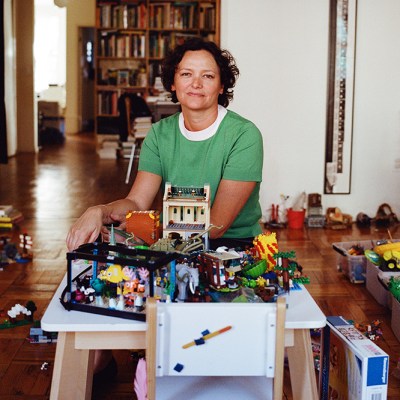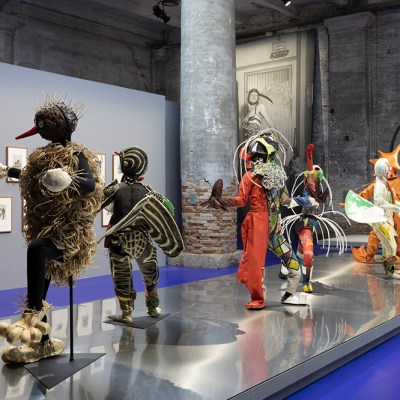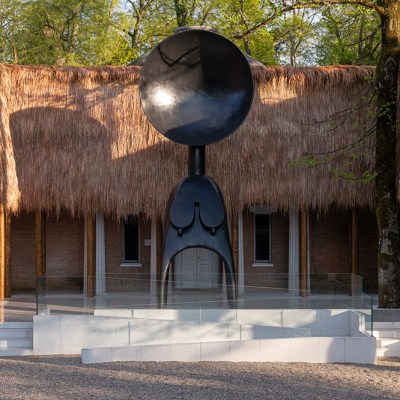Cecilia Alemani
Cecilia Alemani, the curator of the 59th Venice Art Biennale, is the first Italian woman to have been awarded this honour in the Biennale’s 127-year history. The director and curator of the High Line Art programme in New York, who curated the Italian Pavilion at the 2017 edition of the Biennale, chose as her theme ‘The Milk of Dreams’ – a title taken from an illustrated fairy tale by the British Surrealist artist Leonora Carrington. The children’s book depicts a world of hybrid characters who are in constant metamorphosis; stories of transformation that Carrington first painted on the walls of her son’s bedroom in Mexico City. This freedom to change – through prosthetics, genetics, robotics, magic or simply choice – informed the spirit of Alemani’s thoughtful exploration of what Rosi Braidotti calls ‘posthuman knowledge’. Alemani chose art that she believed pointed to new ways of being outside of our current paradigms that have resulted in racism and colonialism, misogyny and sexual discrimination, and the evisceration of the planet.
The 2022 Biennale was delayed by a year because of the pandemic and, unable to travel, Alemani prepared by conducting 400 studio visits over Zoom. The fact that everyone was locked down and in apocalyptic mood gave an intensity to these virtual encounters. Of the 213 artists Alemani chose, from 58 countries, her edition is pioneering in that 90 per cent of participants are female or non-binary: a reversal of the norm. It has been called, predictably, ‘the women’s biennale’. Alemani saw most of the artworks she selected, including 80 new commissions, for the first time as they were being installed in Venice and the vernissage represented a coming together of the art world after a bleak period of closure and isolation. Despite a slump in international tourism, 800,000 visitors came to see ‘The Milk of Dreams’ during its seven-month run (an all-time attendance record), making it the largest and most prominent art exhibition in the world.
The 2022 event was the first that had been postponed since the Second World War. Alemani sees parallels with the post-war 1948 edition, which, after the dark years of fascism, is sometimes referred to as the ‘rebirth’ Biennale. She bought a second-hand copy of the catalogue, once owned by a student called Lucia, who had written in the margins the pointed note: ‘Where are all the women?’ Greece was then embroiled in civil war and Peggy Guggenheim, who had acquired Carrington’s work as early as 1939, took over its national pavilion to display her collection of Surrealism and abstraction, showing Pollock and Rothko for the first time outside the United States. The comparison between 1948 and 2022 became all the more poignant when, just two months before the opening, Russia invaded Ukraine to start a new war in Europe. The Russian pavilion stood empty in the Giardini and nearby a pyramid of sandbags, piled as if protecting a monument, formed the centre of Piazza Ucraina. At the Biennale’s opening, the Ukrainian president Volodymyr Zelensky spoke by video link about the ‘power of art’ to disrupt tyranny.
Alemani was an inspired choice as curator because, as she herself notes, there are certain similarities between the High Line, her usual platform, and the long, awkward space of the Arsenale’s Corderie. This vast and atmospheric but monotonous expanse, where the mooring ropes and rigging of the Venetian fleet were once made, is 317m long. Nothing can be hung on the listed building’s walls or brick columns, making it almost like an outdoor space, as far as a curator is concerned. Alemani chose to open with Simone Leigh’s Brick House (2019), a 4.9m-high bronze bust of a Black woman with a skirt in the form of a clay house, which was first shown on the High Line (it was touch and go whether it would arrive from New York in time for the opening). Leigh was also the first Black woman to be commissioned to create the US pavilion, which she covered with a thatched facade intended to parody the model African villages of the 1931 Paris Colonial Exhibition, passing comment on the imperial legacy of such artistic gatherings.
The density of work on display along the massive run of the Corderie was broken up by other ‘more breathable experiences’, as Alemani described them. After the digital exile of the pandemic, these rhythmic breaks brought back a striking sense of materiality. The Colombian artist and eco-activist Delcy Morelos, for example, filled a large space with soil scented with tobacco leaves and spices, a moment of grounded calm not unlike Walter De Maria’s New York Earth Room (1977) in Manhattan. The Nigerian-American artist and poet Precious Okoyomon presented a series of scarecrow-like effigies in a wild, weedy garden intended as a metaphor for the entanglements of slavery. Only a new commission by Barbara Kruger, which anchored the space, resorted to screens, placed on walls emblazoned with confrontational supergraphics shouting urgent imperatives: ‘PLEASE CARE’; ‘PLEASE MOURN’.
Alemani turned the Covid delay to her advantage by conceiving a transhistorical exhibition that included museum loans – normally impossible to secure because of the Biennale’s fast turnaround. She curated five museum-like sections, mini exhibitions within the exhibition, featuring historic work by mainly women artists. One of these, for example, explored the scientist and philosopher Donna Haraway’s notion of the creative cyborg and featured objects such as the facial prosthetics designed for disfigured First World War veterans by the sculptor Anna Coleman Ladd and 1920s robot-like costumes by the German artist and dancer Lavinia Schulz. Alemani compared the look of these ‘time capsules’ – elegant spaces with wallpaper, fabric and vitrines designed by the Italian studio Formafantasma – to a 1960s Olivetti showroom, the famous one in Venice having been designed by Carlo Scarpa, the architect who designed Guggenheim’s Biennale exhibit.
Lodestars presented in these sections include the women Surrealists Leonora Carrington, Eileen Agar, Dorothea Tanning, Leonor Fini, Remedios Varo and Claude Cahun, who provide the historical, artistic and intellectual roots to contextualise and enrich the contemporary work on show elsewhere. Alemani hoped that their explorations of the irrational or unconscious, the strange and the fantastic, alternative sexualities and indigenous and other-worldly forms of knowledge might show the way to a ‘re-enchantment of the world’. By reinterpreting the past in the light of the present, Alemani pointed to a new future and succeeded in creating a Biennale that was, as she hoped it would be, a ‘factory for the marvellous’.
Cecilia Alemani, photographed by Brad Ogbonna

Christopher Turner is Keeper of Art, Architecture, Photography and Design at the Victoria and Albert Museum.




